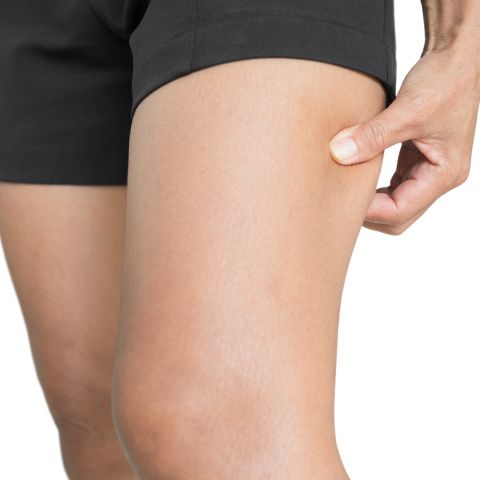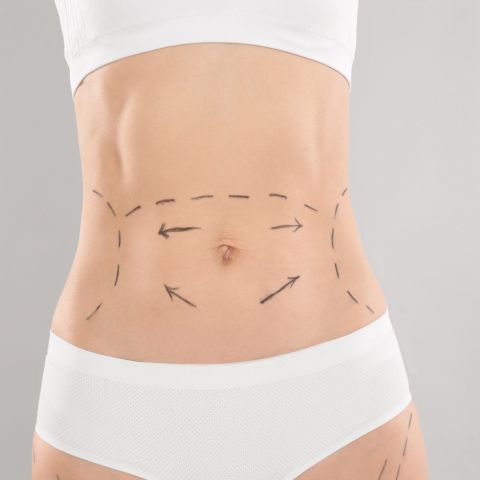

A Thigh Lift, medically known as "thighplasty," is an aesthetic surgical procedure designed to reshape the thighs by reducing excess skin and, in some cases, fat. The goal is to produce smoother skin and more proportionate contours of the thighs and lower body.
There are different types of thigh lifts that target specific areas:
- Inner (Medial) Thigh Lift: This targets the inner thigh, helping to reduce excess skin and fat to give a more toned appearance.
- Outer (Lateral) Thigh Lift: This procedure focuses on the outer thigh and can also lift the buttocks to some extent.
- Bilateral Thigh Lift: This is a more extensive procedure that targets the front and outside of the leg.
People often seek thigh lifts after significant weight loss, and aging that have resulted in sagging skin. The procedure can improve the appearance of the thighs, making them look firmer and more youthful. However, it's essential to note that while a thigh lift can remove excess skin, it's not primarily intended for the removal of large amounts of fat. If fat removal is the main objective, liposuction may be recommended either alone or in combination with a thigh lift.
A thigh lift can offer transformative results for individuals seeking improved contours and skin appearance in the thigh region. However, like any surgical procedure, there are both benefits and potential drawbacks to consider.
Pros of a Thigh Lift:
- Improved Aesthetics: The primary benefit is the removal of excess, sagging skin, leading to smoother and more toned-looking thighs.
- Increased Confidence: By enhancing the appearance of the thighs, many patients experience a boost in self-confidence and self-esteem.
- Comfort: Reducing excess skin can alleviate discomfort caused by skin chafing and irritation, especially during physical activities.
- Clothing Fit: Many patients find that clothing fits better post-procedure, allowing them to wear a wider variety of outfits with confidence.
- Long-Lasting Results: With a healthy lifestyle and weight maintenance, the results of a thigh lift can be long-lasting.
Cons of a Thigh Lift:
- Scarring: Incisions are necessary for the procedure, which can result in scars. However, experienced surgeons aim to place these in less visible locations, like the groin area or the inner thigh.
- Recovery Time: As with most surgical procedures, there's a recovery period involved. Patients might need to take time off work and daily activities.
- Potential Complications: Risks, though rare, include infection, blood clots, poor wound healing, and anesthesia-related issues.
- Not a Weight Loss Solution: A thigh lift is primarily for contouring and skin tightening, not significant fat removal. It's most effective when patients are near their ideal body weight.
- Cost: Aesthetic procedures can be expensive, and since a thigh lift is often considered elective, many insurance companies do not cover the cost.
- Maintenance: Significant weight fluctuations post-surgery can affect the results, so it's crucial to maintain a stable weight after the procedure.
It's essential for individuals considering a thigh lift to consult with a qualified plastic surgeon. The surgeon can provide personalized information, discuss potential risks and benefits, and help determine if a thigh lift is the right choice for the individual's goals and health status.
Individuals might seek a thigh lift for various reasons, primarily driven by aesthetic, functional, or comfort concerns. Here are some common motivations:
- Significant Weight Loss: One of the most common reasons for seeking a thigh lift is after substantial weight loss. While losing weight is beneficial for health, it often leaves behind excess, sagging skin in the thigh area, which doesn't retract or reshape itself naturally.
- Aging: As people age, skin elasticity decreases, leading to sagging skin. A thigh lift can help address this, restoring a more youthful appearance to the thighs.
- Comfort and Mobility: Excess skin in the thigh region can lead to discomfort due to chafing, rashes, or skin infections, especially during physical activities. A thigh lift can alleviate these issues by removing the redundant skin.
- Enhanced Body Contour: Individuals who are dissatisfied with the appearance of their thighs, even without significant weight loss or aging factors, might opt for a thigh lift to achieve a more sculpted look.
- Clothing Fit: Sagging or excess skin on the thighs can make certain clothing, like swimsuits, shorts, or fitted pants, fit poorly or uncomfortably. A thigh lift can allow for a better fit and expanded wardrobe choices.
- Boost in Self-Esteem: Physical appearance can significantly impact self-confidence. By improving the contour and appearance of the thighs, many individuals feel more confident and positive about their body image.
- Previous Procedures: Sometimes, after undergoing other procedures like liposuction in the thigh area, there might be residual sagging skin. A thigh lift can complement previous surgeries by tightening the skin for a more refined look.
Determining whether someone is a good candidate for a thigh lift requires a comprehensive assessment by a qualified plastic surgeon. However, there are general criteria that potential candidates often meet:
- Stable Weight: Ideal candidates are at or near their desired weight and have maintained that weight for some time. Significant weight fluctuations after the procedure can compromise the results.
- Excess Skin: The primary purpose of a thigh lift is to address sagging or loose skin on the thighs. Those with a significant amount of excess skin, often due to major weight loss or aging, are likely candidates.
- General Health: It's important to be in good overall health before undergoing any surgical procedure. Patients should be free from medical conditions that might impair healing or increase surgery risks.
- Non-smoker: Smoking can impede the healing process and increase the risk of complications. Ideal candidates are non-smokers or are willing to quit well in advance of the surgery and during the recovery period.
- Realistic Expectations: Understanding the procedure, its potential outcomes, and limitations is crucial. Patients should have realistic expectations about the results and the recovery process.
- Emotional Well-being: Mental and emotional stability are essential. It's important to seek the procedure for personal reasons and not due to external pressures.
- Commitment to Recovery: Being prepared for the recovery period, which may involve taking time off work, avoiding certain activities, and following post-operative care instructions, is crucial for the best results.
- Minimal Scarring Concerns: Any surgery will result in some scarring. While surgeons make efforts to place incisions in discreet locations, candidates should be comfortable with the possibility of some visible scars.
- Not Primarily for Fat Removal: If the primary concern is excess fat rather than skin, liposuction might be more appropriate. However, the two procedures can be combined if necessary.
- No Active Infections: The surgical area should be free from active infections or certain skin conditions.
The thigh lift procedure aims to tighten and reshape the thigh region by removing excess skin and, in some cases, fat. The specific method and duration depend on the type of thigh lift being performed and the individual's needs.
1. Anesthesia: Typically, the patient is placed under general anesthesia, ensuring they remain pain-free and unconscious throughout the operation.
2. Incision: Depending on the targeted area:
- Inner (Medial) Thigh Lift: An incision is usually made in the groin area, extending down towards the knee along the inner portion of the thigh.
- Outer (Lateral) Thigh Lift: The incision may begin at the groin and extend around the hip, addressing the outer thigh and possibly the buttocks.
3. Reshaping the Thigh: Excess skin is removed, and the underlying tissue is tightened and reshaped. If there's excess fat, liposuction might be employed simultaneously.
4. Closing the Incision: Once the desired reshaping is achieved, the skin is sutured back together. The surgeon may place temporary drains to reduce the accumulation of fluid.
5. Recovery: After the surgery, the patient is taken to a recovery area to be closely monitored as the anesthesia wears off.
General Timeframe:
- Surgery Duration: A thigh lift usually takes between 2 to 3 hours, but this can vary based on the extent of the procedure and if other treatments, like liposuction, are combined with it.
- Hospital Stay: Some patients can go home the same day, while others might need an overnight stay in the hospital.
- Recovery Period: Patients typically need 1-2 weeks off work or school. Swelling and bruising may last several weeks. It's advised to avoid strenuous activities for about 4-6 weeks.
- Full Results: While some improvements are immediate, the final results, especially in terms of scar maturation and contour settling, may take several months to become fully apparent.
Always consult with a qualified plastic surgeon to get a detailed understanding of the procedure, potential risks, and expected outcomes tailored to individual needs.
The recovery period after a thigh lift is crucial for ensuring optimal results and minimizing potential complications. Here's what patients can generally expect during this time:
- Immediate Post-Op: After the procedure, patients will be in a recovery area for monitoring as the anesthesia wears off. Depending on the surgery's extent and the surgeon's recommendations, patients may be discharged on the same day or might require an overnight hospital stay.
- Pain and Discomfort: Some pain and discomfort are normal following the procedure. Patients will typically be prescribed pain medications to manage this. Over-the-counter pain relievers might also be recommended, but always consult the surgeon before taking any medication.
- Swelling and Bruising: These are common post-operative symptoms. Using cold compresses and keeping the legs elevated can help reduce swelling.
- Drains: Some patients may have surgical drains placed to remove excess fluid from the surgical site. The surgeon will provide instructions on how to care for these drains and when they will be removed.
- Compression Garments: Patients will likely be advised to wear compression garments for several weeks. These help reduce swelling, support the surgical area, and promote healing.
- Limited Mobility: Initially, movements might be restricted, especially when it comes to activities that strain the thighs. Walking is encouraged as soon as possible to promote circulation, but strenuous activities, including heavy lifting and vigorous exercise, should be avoided for about 4-6 weeks or as directed.
- Incision Care: Keeping the incision area clean and dry is vital. The surgeon will provide guidance on cleaning the area and changing dressings. It's essential to monitor the incision for signs of infections, such as increased redness, warmth, pus, or persistent pain.
- Scarring: Scarring is a natural part of the healing process. The appearance of scars will improve over time, and there are treatments and ointments available that can help minimize their appearance.
- Follow-Up Appointments: Regular check-ups with the surgeon are essential to monitor the healing process. During these visits, stitches or drains might be removed, and the surgeon will assess the surgical site for any complications.
- Long-Term Results: While some changes will be immediately noticeable, the final contouring and appearance may take several months to stabilize as swelling subsides and tissues settle.
- Emotional Aspects: It's common for patients to experience a range of emotions after surgery, from elation at the results to moments of doubt or sadness. It's essential to have a support system in place and consider seeking emotional support or counseling if needed.
Every patient's recovery experience can vary, so it's crucial to follow the specific post-operative instructions provided by the surgeon and report any unusual symptoms or concerns immediately.
Proper care of the surgical site after a thigh lift is essential to prevent complications, promote healing, and ensure the best possible results. Here's a general guideline on how to care for the surgical site:
- Dressings/Bandages: Keep the dressings or bandages clean and dry at all times. Your surgeon will give you instructions on how often to change them.
- Drains: If surgical drains are placed, you'll be given specific instructions on how to care for and empty them. Monitor the amount and color of the drainage and report any significant changes to your surgeon.
- Compression Garments: Wear any prescribed compression garments consistently, as they help reduce swelling, support healing tissues, and improve blood circulation. Make sure to wear them as directed by your surgeon.
- Cleaning the Incision: Once you're allowed to wash the area, do so gently with mild soap and water. Pat the area dry—do not rub. Avoid submerging the incision in water, such as in baths or swimming pools, until fully healed.
- Topical Treatments: Do not apply creams, ointments, or lotions to the incision unless recommended or prescribed by your surgeon. Some products can interfere with the healing process.
- Monitoring for Infection: Keep an eye out for signs of infection, which can include increased redness, warmth, swelling, pus, or a foul odor from the incision site. Additionally, if you develop a fever or persistent pain, contact your surgeon immediately.
- Avoid Direct Sunlight: Protect the incision from direct sunlight, as it can darken the scar. If you have to be out in the sun, use sunscreen on the scar once it's fully healed to prevent hyperpigmentation.
- Avoid Strenuous Activity: Refrain from activities that stretch or strain the surgical area for the initial weeks after the procedure. Always follow your surgeon's guidance on when it's safe to resume regular activities and exercises.
- Stay Hydrated and Eat Well: Proper nutrition aids in the healing process. Consume a balanced diet rich in proteins, vitamins, and minerals, and stay hydrated.
- No Smoking: Smoking can severely impair the healing process by constricting blood vessels and reducing blood flow to the surgical area. It's crucial to avoid smoking before and after surgery.
- Regular Check-Ups: Attend all follow-up appointments so your surgeon can monitor your healing progress and address any potential issues or concerns.
- Follow Prescribed Medications: Take all medications, including antibiotics and pain relievers, as prescribed. If you experience any side effects or think you might be having an allergic reaction, contact your surgeon immediately.
- Sleeping Position: Consider sleeping with your legs slightly elevated to reduce swelling. Avoid sleeping on your sides or placing direct pressure on the thighs for the initial period after surgery.
Remember, these are general guidelines. Always follow the specific post-operative instructions given by your surgeon and ask any questions if you're unsure about any aspect of your aftercare.
Turkey has become a go-to destination for medical tourism, largely due to its attractive pricing structure. This affordability stems from a combination of factors. First, the overall cost of living in Turkey is significantly lower than in many Western countries, which naturally translates to reduced medical service costs. Additionally, the Turkish government actively endorses and incentivizes medical tourism, providing support to healthcare establishments catering to overseas patients. This governmental backing, combined with the high volume of surgeries undertaken, permits economies of scale, leading to even more cost-efficient procedures without compromising on quality.
When it comes to thigh lift surgery, the cost differences between Turkey, Western Europe, and the USA are noteworthy. In Turkey, patients might expect to pay anywhere between $2,500 to $5,000, contingent on the surgeon's experience and the clinic's reputation. Meanwhile, Western Europe's pricing, covering countries like the UK, France, and Germany, usually oscillates between $6,000 to $10,000. The USA tops the chart with costs ranging from $7,000 to $15,000, influenced by the state and surgeon's credentials. While these figures highlight the potential savings in Turkey, it's paramount for patients to factor in the surgeon's expertise, facility standards, and post-operative care when making a decision.
Choosing the right medical tourism agency is pivotal to ensuring a safe and satisfying experience, especially when undergoing a significant procedure like a thigh lift. Here's why Elara Medical Tourism stands out for your thigh lift procedure in Turkey:
1. Experienced Network: Elara Medical Tourism collaborates with some of the most renowned and skilled surgeons and hospitals in Turkey. This ensures that patients receive top-tier care from experts who are proficient in the latest techniques and procedures.
2. Comprehensive Care: From the initial consultation to post-operative check-ups, Elara ensures a seamless and holistic care journey. They manage everything – from arranging travel and accommodations to scheduling medical appointments, ensuring patients can focus solely on their recovery.
3. Transparent Pricing: With Elara, there are no hidden charges. Patients receive a clear breakdown of costs, making it easier to plan without the fear of unexpected expenses.
4. Personalized Service: Every patient is unique, and Elara recognizes this. They offer tailored solutions based on individual needs and preferences, ensuring each patient's experience is personalized to their requirements.
5. Safety and Quality Assurance: Elara's stringent vetting process guarantees that patients are directed to accredited hospitals with high standards of hygiene and care. Their unwavering commitment to patient safety is evident in the measures they implement.
6. Language and Cultural Assistance: For international patients, language can be a barrier. Elara offers translation services and cultural guidance to ensure patients feel at ease and fully understand their treatment.
7. Post-Operative Support: The care doesn't end after the procedure. Elara's team remains accessible to patients, providing guidance and support throughout the recovery period.
8. Local Knowledge: Having extensive knowledge of Turkey, Elara can offer patients insights into local attractions, activities, and cultural experiences, making their stay not just about the procedure but also an enriching experience.
In summary, choosing Elara Medical Tourism is about more than just a surgical procedure. It's about entrusting your care to a team that prioritizes your health, safety, and overall experience, ensuring that your medical journey in Turkey is as comfortable and rewarding as possible.




